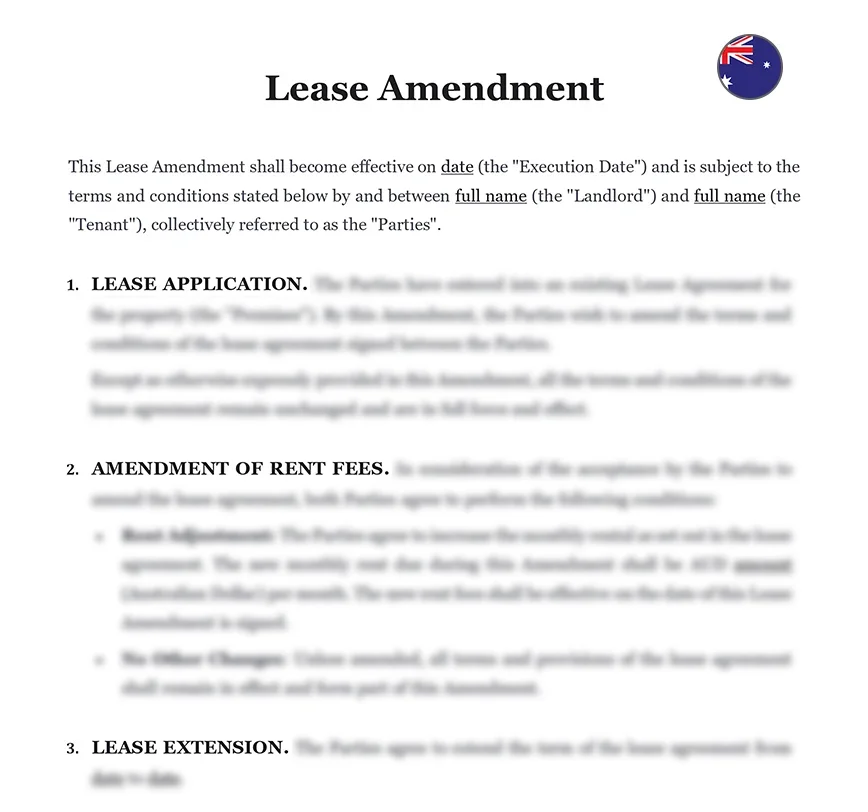Ready to use legal template
Drafted by experienced lawyers
Compliant with Australian law
Ready to use legal template
Drafted by lawyers
Compliant with Australian law
Home › Rent your property › Lease amendment
Learn more about Lease Amendment in Australia
In Australia, a Lease Amendment serves as a critical legal document used to modify or update existing lease agreements. Whether extending the lease term, adjusting rent rates, or adding new tenants, this document ensures that any changes to the original lease are properly recorded and agreed upon by all parties involved. Recognizing the importance of accuracy and legality in such matters, we offer an easy-to-edit legal template meticulously drafted by legal experts to facilitate the process of amending leases in compliance with Australian laws and regulations.
Table of contents
-
What is a Lease Amendment and when is it necessary?
-
Can a lease be amended before the end of its term?
-
What changes can be made to a lease in Australia?
-
Do all parties need to agree to the proposed amendments?
-
How long can a lease be extended in Australia?
-
Can rent increases or decreases be included in a Lease Amendment?
-
How does adding or removing tenants affect the lease agreement?
-
What happens if one party refuses to agree to the proposed amendments?
What is a Lease Amendment and when is it necessary?
A Lease Amendment in Australia is a legally binding document that modifies or alters specific terms and conditions of an existing lease agreement between a landlord and a tenant. These amendments serve to update the lease to reflect changes in circumstances or to address issues that may arise during the term of the lease. Lease Amendments can cover a wide range of topics, including rent adjustments, changes to lease duration, modifications to the permitted use of the premises, or revisions to other contractual terms. They are drafted to ensure clarity and enforceability and are signed by both parties to signify their agreement to the proposed changes.
A Lease Amendment may be necessary in various situations that require adjustments to the terms of the original Lease Agreement. Common reasons for seeking a lease amendment include changes in rent due to market fluctuations or financial considerations, modifications to lease terms to accommodate evolving business needs or operational requirements, or updates to reflect improvements or alterations made to the leased premises. Additionally, Lease Amendments may be necessary to address issues such as lease extensions, subleasing arrangements, or changes in ownership or management of the property.
Can a lease be amended before the end of its term?
Yes, a lease can be amended before the end of its term, provided that all parties involved agree to the proposed amendments. Lease amendments are alterations or modifications made to the terms of the lease agreement after it has been signed. These amendments can address various aspects of the lease, such as rent adjustments, changes to lease duration, or modifications to lease terms and conditions. However, any amendments must be mutually agreed upon by both the landlord and the tenant, and the revised terms should be documented in writing to ensure clarity and enforceability.
What changes can be made to a lease in Australia?
In Australia, various changes can be made to a lease through amendments, including but not limited to:
| ➤ Rent adjustments: Changes to the amount of rent payable, frequency of rent payments, or method of rent calculation. |
| ➤ Lease duration: Extending or shortening the lease term, including options for renewal or termination. |
| ➤ Maintenance responsibilities: Clarifying or modifying obligations related to property maintenance, repairs, and upkeep. |
| ➤ Use of premises: Allowing or restricting specific uses of the leased premises, such as for commercial, residential, or industrial purposes. |
| ➤ Assignment or subletting: Allowing or prohibiting the tenant from assigning the lease or subletting the premises to another party. |
| ➤ Other terms and conditions: Making adjustments to other lease provisions, such as security deposit requirements, insurance obligations, or dispute resolution mechanisms. |




